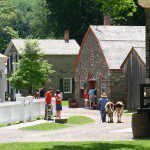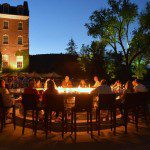Cooperstown Memories: Baseball, Opera, Small Towns
By • August 17, 2015 0 1579

Before we travel to a new place, we stuff our luggage full. We pack the things we know and remember. We pack expectations, a kind of act of the imagination about how things might be, what we’ll see and feel. We pack our own memories.
We went to Cooperstown in upstate New York. We came initially because of opera—the Glimmerglass Festival and its artistic director Francesca Zambello, who also runs the Washington National Opera. We came also because of the church of baseball, the Baseball Hall of Fame in Cooperstown, where baseball’s inventor or grand developer Abner Doubleday lived. It is not the house that Babe Ruth built, but it is where he and hundreds of baseball’s finest are honored pretty much forever.
We discovered, too, that Cooperstown was founded by the father of James Fenimore Cooper, the town’s most famous author and America’s first novelist of any note, best known for “The Last of the Mohicans.”
Armed with this, we noted the presence of the Fenimore Art Museum, alongside the expansive and beautiful Leatherstocking Golf Course, which is part of the more than 100-year-old Otesaga Resort Hotel, and also runs across Lake Street, next to the modestly titled Farmers’ Museum. If you stay on that road and drive all the way around the lake, you will end up where you started: on Main Street in Cooperstown.
So, I came to Cooperstown already armed with some notions and memories. I—as well as my boon companion and partner—grew up in small towns, with similar populations and tropes, in Ohio and Pennsylvania, respectively. I came to Cooperstown as an erstwhile German immigrant who spent the 1950s following the Cleveland Indians in their annual baseball wars with the New York Yankees, part of a youthful love affair with baseball that has never much abated. I thought it cannot get much better than this: baseball, opera, small town and James Fenimore Cooper, whose works I had only experienced in their Classic Illustrated comic book versions or as movies.
We stayed on the outside of the town at a Best Western Plus, where in the morning you could see mist and fog on the hills outside. We made our way into town—you hit Main Street at the town’s only stoplight—and I soon found out that everything I thought I knew was incomplete.
Cooperstown is a real place, not just the Hall of Fame.
If you’re an outdoor person, there are plenty of parks and recreational offerings—boating, biking, hiking, fishing. There are plenty of restaurants, farmers’ markets, distilleries and regional breweries. The influence of Whole Foods is not much in evidence.
Drive into town for the first time, and you’ll see the sign Redneck Barbecue brashly displayed on a roof in big colors.
This co-mingling of informality works its way through the town and the places you’ll see, oh my—even to some degree at elegant, impressive Otesaga Resort Hotel, the flagship of accommodations for the area. Buffet and lunch breakfast are a welcome offerings for travelers as well as guests, where eating by the window seats or outside retains an elegant, peaceful feeling. It makes you want to read a book by Henry James.
This probably comes as no surprise, nor is the excellent quality of the art works in the Fenimore Museum, including special exhibition currently of the works of Maxwell Parrish, as well as an impressive array of Native American art, among others.
You will be surprised by the Farmers’ Museum across the way from Fenimore. It contains a facsimile working village and farm, covering bygone days in American life—from a church, to a barn, a newspaper office, sheds and a blacksmith, barnyard animals shyly watching tourists, women sewing, the kitchens, bedrooms, dining rooms and libraries of both gentry and small town folks. There’s a Brigadoon quality to this. Imagine what would happen if you dropped a mobile electronic device into this serene scene. It might have the effect of a cultural, social nuclear device.
Around the lake a ways, you’ll encounter Hyde Hall, where executive director Jonathan Maney holds forth on one of the oldest residences around —it was built by an Englishman named George Clarke on a 60,000-acre estate with the help of renowned architect Philip Hooker. Ever since 1964, Hyde Hall has been under some sort of renovation to return it to its original grandeur, which in full glory was considerable. As Clarke was British, and after having the original cottage built, he strove for a touch of English landed aristocracy in the grand manner for a grand manor. Today, Maney, who is a historian, a former professor and a great storyteller, tells us that it is used for weddings, concerts, galas, picnics, lectures and exhibitions. Inside the vast home, which started out as a cottage, there are its paintings, prints, copies (of the inventor-artist Samuel Morse’s painting, “Gallery of the Louvre”), sculptures and rooms upon rooms, dark stairways, expansive window views of a courtyard, children’s rooms as well as a wine cellar fully stocked.
On Main Street, Cooperstown, however, it is baseball everywhere, memorabilia shops (like Mickey’s Place) everywhere. A statue of a youthful Shoeless Joe Jackson stands near Doubleday Field. After all that, at the end of Main Street sits the Baseball Hall of Fame itself, which this weekend (July 24 to 27) will induct four new members—Craig Biggio, Randy Johnson, Pedro Martinez and John Smoltz—during four days of nothing but baseball, including the presence and a parade of hundreds of the game’s living legends and hall members.
From the outside, the hall doesn’t look like much. It seems small, until you walk inside and enter what is not so much a hall of fame but a hall of dreams. The three floors are filled with exhibits on teams, on the history of the games, on individuals like Hank Aaron, the Babe and Joe DiMaggio, on ball parks, the Negro Leagues, and most holy of holies, the true hall that contains plaques of every player inducted into the hall. Prominently located are sculptures of Ted Williams and Babe Ruth, where a small player is trying to imitate Ruth’s batting stance.
It’s an impressive place, a kind of church that’s full of reverence, references and irreverence. It’s a place where the playing of “Take Me Out to the Ballgame” can suddenly bring you close to tears. It’s what happens here that matters, the buzz in every hall, young boys and some girls in baseball uniforms all over the place, the chit chat of the game whizzing through the wandering crowds like a giant murmur. On another floor, a dozen people are gathered around a screening of the Abbott and Costello comedy routine “Who’s on First,” laughing hard. Among the plaques, I find Ernie “Play Two,” the Chicago Cub and greatest player never to play in a World Series. His face shows a smile, and so does a woman looking at him. She’s an unrequited Cubs fan. We look at a plaque for Cubs manager Leo “The Lip” Durocher. She grimaces. “That S.O.B. cost us the pennant,” she says with some rancor.
After a trip to a new place, you return with more than you brought—more stuff, more maps, more books and souvenirs. More memories.
I unpacked memories of printer’s ink, an embarrassed turkey avoiding children at the farm, the two warm women who ran the carousel, the taste of cherry in a draught beer, the smoke on the hills, Papageno meeting Papagana in “The Magic Flute,” Solomon Howard’s eloquent basso voice in the two operas and bass baritone Eric Owens who saw ghosts, jumped on a table and owned Macbeth, a drive along Lake Street at midnight with a mother deer in the headlights, the sight and names of all the baseball players bringing back summer nights in Ohio, Maney describing in detail the process for lighting a Hyde chandelier and talking about his grandmother who had survived the fatal voyage of the R.M.S. Titanic, the rustle of white curtains at the resort moved by a breeze from Lake Otsego.
- Front of the 100-year-old Otesaga Resort Hotel. | Photo courtesy Otesaga Resort Hotel.
- Copyright Kristen Finn






